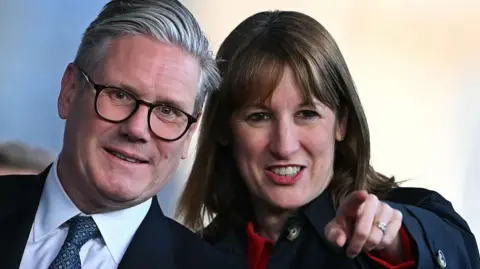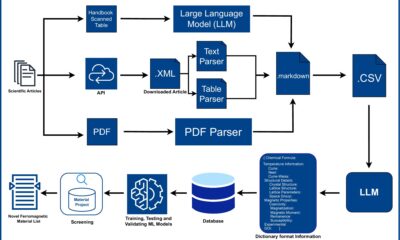Business
Can Labour reverse ‘desperate loss of faith’ from business?

Simon JackBusiness editor
 WPA Pool/Getty Images
WPA Pool/Getty ImagesOne of the key audiences that the prime minister and the chancellor will have to convince at this year’s Labour conference are the business leaders they targeted with a charm offensive before the election last July.
The party trumpeted itself as “the natural party of business” and Rachel Reeves told anyone and everyone that this would be “the most pro-business government this country has ever seen”.
Labour had some big business beasts backing them. Billionaire mobile phone tycoon John Caudwell – a long-time Conservative supporter – switched his backing to Labour.
Some 120 business leaders signed a letter which read: “We, as leaders and investors in British business, believe that it is time for a change. For too long now, our economy has been beset by instability, stagnation, and a lack of long-term focus.
“Labour has shown it has changed and wants to work with business to achieve the UK’s full economic potential.”
But post-election, the party sent a different message – warning of tough choices and hard times ahead, and delivered a Budget to prove it.
That Budget, says John Caudwell, with its £25bn rise in employers’ National Insurance, undid a lot of the goodwill the chancellor had garnered.
“I think there was a desperate loss of faith from the business community in general from the last Budget,” he says. “I think people were shocked at the level of negative components for businesses.”
On top of that NI rise, the National Living Wage was hiked by an inflation-busting 6.7%, with a rise of 16% for 18 to 20-year-olds.
Mr Caudwell says he understands that Labour needed to raise money to shore up the public finances but felt it hit some sectors unduly hard.
“Even if you say they needed to be done, certain aspects were very unfair. So if you look at the increase in employers’ NI, that really badly hit those businesses that employ tens of thousands of people on low wages, because they got hit by minimum wage and they got hit by the NI.”
 PA
PAOther small business owners have also told the BBC they have lost confidence.
Rachel Carrell is the boss of childcare firm Koru Kids and signed that letter in 2024. She says she hopes the government can restore business confidence over the rest of the parliament.
“I wouldn’t sign that letter today but they’ve got three or four years to turn this around. That’s a really long time.”
She believes there’s an opportunity to fix things in the upcoming Budget, but says “they need to move quickly”.
While anecdotal evidence of crumbling business confidence is not hard to find, official measures show a mixed picture.
The Institute of Directors’ confidence measure shows a steep fall after the last election, which compilers put down to immediate warnings issued by the government once in power that tough times and tough choices lay ahead.
That was duly delivered on by the Budget and has hovered near those lows ever since.
However, the government’s favourite index to quote is the Lloyds Bank confidence survey, which shows confidence on the future is much more robust.
Other measures, including the ICAEW and the S&P PMI measures, tend to support a more gloomy outlook.
That in turn is supported by the number of businesses looking to recruit.
Job vacancies have been on a downward trend since the Covid pandemic and there are 150,000 fewer staff on payrolls now than there were before the Budget bombshell, with a large part of those jobs going in hospitality.
However, there is widespread hope among smaller businesses that the long-promised overhaul of business rates will come soon and in their favour.
The government points understandably to the enormous amounts of money pledged recently when tech royalty from Apple, Nvidia, Microsoft and others met real royalty at US President Donald Trump’s recent state visit.
John Caudwell welcomed it too.
“I hear a lot of negativity about government – we hear about rich people leaving and they are useful to the UK economy, but they’re not as useful as the £150bn of inward investment that we’ve got coming into the country to create high-paid jobs in high-technological businesses. So we have to get a balanced view on that.”
Mark Hargreaves runs a trolley and tray manufacturing and export business in Peckham, south London. He is less impressed with the razzamatazz surrounding the tech billionaires and their largesse.
“I’m sure it’s very important to get these racy high-growth sectors to invest here. But what about the less exciting bits of the economy – the ones who are always here? We feel forgotten.
“I was hopeful that a new government would give us some help but all my costs have gone up – my business rates have doubled. I’m more cautious about investing in a new machine, a new product, hiring a new person.”
The new Employment Rights Bill, which confers greater rights and protections on employees from day one, is also adding to employers’ reluctance to take on new staff.

The government has made much of its plans to sweep away impediments to economic growth and has seen that acknowledged by some of the biggest investors in UK infrastructure.
Just months after Labour entered Downing Street, Scottish Power announced a £24bn UK investment.
Keith Anderson, chief executive of Scottish Power, says: “The government has taken on the planning bogeyman to unlock growth and get us building. That’s why the UK is now Iberdrola’s biggest investment destination globally.”
Rain Newton-Smith, director general of the employers group the CBI, also gives the government high marks on the international stage.
“I think this government have navigated really difficult geopolitics. We’ve got a better deal with the US than others, we’re forging a closer relationship with Europe and they got the deal with India.
“They’ve got a lot of work done internationally, and that does count. But they’ve really got to dial up delivery, and make sure that they they learn from the mistakes of last autumn.”
Business confidence is a vital but fragile thing. It’s a key ingredient for any government hoping that economic growth will pay for its other spending commitments – on heath, defence and welfare.
Labour has a job on its hands at conference, and at the Budget, to restore the animal spirits of UK business.
Business
Indias Wholesale Inflation Bottomed Out, May Still Remain Negative Through 2025-26: Report

New Delhi: India’s Wholesale Price Index (WPI) or wholesale inflation has “bottomholesale inflation bottomed out, may still remain negated out” and will probably gain slight momentum from November onwards, even as it may still remain in negative territory for most of the remaining months of 2025-26, Union Bank of India said in a report.
The Bank’s 2025-26 WPI forecast is currently tracking below 0.35 per cent amid what are being stated as subdued global commodity prices and a seasonal decline in food prices (with the impact of floods on food inflation seen to be capped).
“Food WPI remains depressed – spatial flooding and supply-chain disruptions did not materialise as expected, keeping food prices contained,” the report read. With 2025-26 Consumer Price Index (CPI) or retail inflation projections of the Union Bank of India also running sharply below the RBI’s latest estimates, it expects a 25 basis points repo rate cut in the upcoming December monetary policy review meeting.
While real GDP growth momentum remains robust, the report asserts that nominal GDP growth is expected to come under pressure due to subdued 2025-26 CPI and WPI projections. India’s wholesale inflation turned negative in October, with the Wholesale Price Index (WPI) recording a decline of (-) 1.21 per cent in October 2025 compared to the same month last year, according to official data released by the Ministry of Commerce and Industry on Friday.
A decrease in the costs of food articles, crude petroleum, natural gas, electricity, mineral oils, and basic metals mainly drove the fall in prices. The Ministry stated that the month-on-month change in WPI for October stood at (-) 0.06 per cent compared to September 2025.
The government releases the index number of wholesale price in India every month on the 14th of every month (or next working day, if the 14th falls on a holiday) with a time lag of two weeks of the reference month, and the index number is compiled with data received from institutional sources and selected manufacturing units across the country.
Inflation has been a concern for many countries, including advanced economies. However, India has largely managed to steer its inflation trajectory in a favourable direction. The RBI held its benchmark repo rate steady at 6.5 per cent for the eleventh consecutive time, before cutting it for the first time in about five years in February 2025.
Business
Gems trade slump: Exports fall 31% in October; bullion volatility, early US stocking hit demand – The Times of India

India’s gems and jewellery exports fell sharply in October, sliding 30.57% to $2.17 billion (Rs 19,172.89 crore) compared to the same month last year, according to data released by the Gems and Jewellery Export Promotion Council (GJEPC), PTI reported.Exports in October 2024 had stood at $3.12 billion (Rs 26,237.1 crore).GJEPC chairman Kirit Bhansali said the decline was largely expected, as overseas buyers had advanced their festive-season stocking before the US tariff came into effect.“Most of the stocking up for the festivals took place before August 27. Therefore, in October the demand was down. The decline in gold and silver exports is triggered by volatile bullion prices,” Bhansali told PTI.He added that exports should revive in November with Chinese market recovery and Christmas demand from major global buyers.Exports of cut and polished diamonds fell 26.97% to $1.02 billion (Rs 9,071.41 crore), down from $1.40 billion (Rs 11,806.45 crore) a year earlier.Shipments of polished lab-grown diamonds also saw a steep slide of 34.90% to $94.37 million (Rs 834.45 crore), compared with $144.96 million (Rs 1,218.25 crore) last October.Gold jewellery exports dropped 28.4% to $850.15 million (Rs 7,520.34 crore) from $1.18 billion (Rs 9,975.17 crore) a year earlier.Exports of coloured gemstones during April–October slipped 3.21% to $250.14 million (Rs 2,173.08 crore).Silver jewellery shipments dipped 16% in October to $121.37 million (Rs 1,072.81 crore), down from $145.05 million (Rs 1,219.01 crore) in 2024.
Business
DAMAC Properties Unveils Master Development, Launches New Sales Office In Egypt

Last Updated:
DAMAC launched DAMAC Islands 2 and a new Cairo office at the Grand Egyptian Museum, with Hussain Sajwani and Amira Sajwani hosting. Omar Khairat performed.

DAMAC (Representative Image)
DAMAC marked the launch of its new master development DAMAC Islands 2 and its new sales office opening in Egypt with a grand celebration in Egypt at the magnificent Grand Egyptian Museum, an architectural and cultural marvel overlooking the Pyramids of Giza. The glittering evening set against the backdrop of ancient history was hosted by Hussain Sajwani, Founder and Chairman of DAMAC Group, and Amira Sajwani, Managing Director of DAMAC Properties, who welcomed an audience of dignitaries, global investors, media, brokers, and VIP guests from across the world.
Guests at the event were given an exclusive preview of DAMAC Islands 2, the latest luxury community in Dubai, inspired by eight tropical island destinations. The project followed the phenomenal success of DAMAC Islands 1 in 2024, which achieved a record-breaking sell-out. DAMAC sold AED 10 billion in inventory, generating the highest revenue from a real estate launch in 24 hours, as recognised by the Guinness World Records.
The evening’s headline act was legendary Egyptian musician Omar Khairat, who regaled the audience with a captivating fusion of classical, jazz, and traditional Arabic music. Hadi Awada presented a thrilling, choreographed performance.
Hussain Sajwani, Founder of DAMAC Group, said: “This grand celebration and our presence in Cairo represents an affirmation of our deep connection with Egypt. This market has long been one of our most dynamic and promising markets. We’re here to bring DAMAC’s international portfolio closer to Egyptian investors who seek both quality and long-term value.”
Amira Sajwani, Managing Director of DAMAC Properties, noted: “Egyptians already rank among the top ten nationalities purchasing DAMAC homes. We have witnessed double-digit sales growth in this market and expect it to rise another 20% in 2026. Opening our Cairo office also brings us closer to our clients and strengthens the bridge between Cairo and Dubai, the two powerhouses of real estate investment in the MENA region.”
Dubai’s real estate market remains one of the world’s most active and attractive amongst investors and residents alike – with H1 2025 transactions up 40% year-on-year, reinforcing DAMAC’s position at the intersection of two of the region’s most vibrant markets. Furthermore, DAMAC communities continue to lead market performance, with DAMAC Islands recording 4,185 villa and townhouse sales in H1 2025 and DAMAC Hills 2 registering 1,942 sales.
On average from launch, price growth at DAMAC Hills 1 townhouses rose 86 per cent, DAMAC Hills 1 villas 72 per cent, DAMAC Hills 2 townhouses 60 per cent, and DAMAC Islands villas 29 per cent, demonstrating sustained investor confidence in the brand’s long-term value.
DAMAC Islands 2 brings the rhythm of the tropics to the heart of Dubai; blending lush landscapes, crystal lagoons, and wellness-driven design inspired by eight dream destinations: Antigua, Bahamas, Barbados, Bermuda, Cuba, Maui, Mauritius, and Tahiti. As part of the launch campaign for DAMAC Islands 2, DAMAC also launched a unique global competition to become ‘The Ultimate Islander’.
The competition winner will receive an all-expenses-paid trip and become an employee of DAMAC while living on one of their eight islands. The master-planned project will comprise six-bedroom luxury villas of approximately 583 square meters, five-bedroom twin villas of approximately 324 square meters, five-bedroom townhouses of approximately 293 and 263 square meters, and four-bedroom townhouses of approximately 203 square meters. Prices start at AED 2.7 million.
A team of writers and reporters decodes vast terms of personal finance and making money matters simpler for you. From latest initial public offerings (IPOs) in the market to best investment options, we cover al…Read More
A team of writers and reporters decodes vast terms of personal finance and making money matters simpler for you. From latest initial public offerings (IPOs) in the market to best investment options, we cover al… Read More
November 15, 2025, 13:25 IST
Read More
-

 Entertainment1 week ago
Entertainment1 week agoChina unveils£5.4 bn Fujian, its most advanced aircraft carrier yet
-

 Politics1 week ago
Politics1 week agoIDF lawyers warned of possible Gaza war crimes: US intel findings
-

 Entertainment1 week ago
Entertainment1 week agoRobert Pattinson jokes about competing with Gen Z
-

 Tech1 week ago
Tech1 week agoThe Government Shutdown Is a Ticking Cybersecurity Time Bomb
-

 Sports1 week ago
Sports1 week agoIsraeli cycling team loses top sponsor despite honoring request to remove country from name
-

 Entertainment1 week ago
Entertainment1 week agoAlex Cooper apologizes to Taylor Swift for bizarre admission
-

 Tech1 week ago
Tech1 week agoMagnetic materials discovered by AI could reduce rare earth dependence
-
Sports6 days ago
College football winners and losers: The catch of the year saves Indiana







